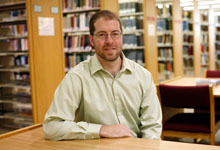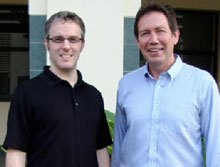School of Education faculty present intriguing research at AERA
A few highlights from the international meeting in Vancouver, BC April 13-17
Below is just a sample of some research presented by IU School of Education faculty (along with many doctoral students and research assistants) at the annual American Educational Research Association annual meeting in Vancouver, BC. More than 100 IU researchers took part, many from the School of Education.
Study: Reasons for school suspension and expulsion complex; race still central
A new study shows that race continues to be an important factor in determining who receives out-of-school suspension and expulsion, and that racial disparities in school discipline are most likely due more to school characteristics than to the characteristics of behaviors or students.
Russ Skiba, professor in counseling and educational psychology at the Indiana University School of Education, led the study, exploring factors affecting disproportionate rates of suspension and expulsion for African-American students. Skiba is director of The Equity Project, offering evidence-based information on equity in special education and school discipline, based in the Center for Evaluation and Education Policy at IU Bloomington.
The study was presented April 13 in Vancouver during the annual meeting of the American Educational Research Association.
"For overall rates of suspension and expulsion, the study found that discipline is not just a function of difficult students receiving punishment but is more complex," Skiba said.
Type of misbehavior, student characteristics including race and socioeconomic status, and school characteristics, such as the principal's views on school discipline, all predict which students will be suspended or expelled. In particular, the study found race to be a key factor.
"It continues to be a powerful predictor of the severity of school punishment, independent of poverty status or the type of behavior students engage in," Skiba said. "In particular, schools with more African-American students are more likely to use more exclusionary forms of discipline such as suspension or expulsion."
He said the researchers found that poverty rates and more disruptive behavior didn't account for the racial disparities. Instead, the characteristics of schools themselves, including principal attitudes regarding discipline, are most important in accounting for racial differences.
Here are some of the findings:
- After controlling for both poverty and the seriousness of behavior, African-American students remain 1.5 times more likely than white students to receive an out-of-school suspension.
- Students in schools with higher proportions of black students are almost 6 times more likely to receive an out-of-school suspension.
- Students in schools where a principal supports preventive alternatives to suspension are 30 percent less likely to receive an out-of-school suspension, and more than 50 percent less likely to receive an expulsion.
Skiba said the results are consistent with other recent reports, including a report released last month by the U.S. Department of Education's Office for Civil Rights that found national data indicate African-American students are far more likely than peers to be suspended.
"It is especially troubling that these results support previous research in showing that schools with higher proportions of African-American students use more punitive procedures, regardless of the socioeconomic level of the schools," Skiba said.
"It's no surprise that schools face tough and complex decisions in trying to keep schools safe and orderly," Skiba said, but he added that the results also have important implications for addressing racial differences in discipline. "If we really wish to make a difference in reducing racial and ethnic disparities in suspension and expulsion, these findings suggest that we would do better reflecting upon school policies and practices than focusing on characteristics of students or their behavior."
Skiba presented "Parsing Disciplinary Disproportionality: Contributions of Behavior, Students, and School Characteristics to Suspension and Expulsion" on April 13. Co-authors include Robin Hughes, associate professor of higher education and student affairs at Indiana University-Purdue University Indianapolis; IU Bloomington doctoral students Megan Trachok and Timberly Louise Baker; and IU Bloomington statistician Choong-Geun Chung.
Historically black colleges and universities may be more supportive of students, more engaging in teaching
 An Indiana University study that analyzed differences in practices between faculty at historically black colleges and universities (HBCUs) and predominantly white institutions (PWIs) found that faculty members at HBCUs were more likely to engage students in certain "educationally purposeful" activities both in and out of the classroom.
An Indiana University study that analyzed differences in practices between faculty at historically black colleges and universities (HBCUs) and predominantly white institutions (PWIs) found that faculty members at HBCUs were more likely to engage students in certain "educationally purposeful" activities both in and out of the classroom.
The study was conducted by Thomas Nelson Laird, associate professor in the higher education and student affairs program in the Indiana University School of Education in Bloomington. Nelson Laird also works on the National Survey of Student Engagement and its related surveys. Co-authors include higher education doctoral students Mahauganee Shaw, Eddie Cole and Cameron Harris.
Educationally purposeful activities, those that lead to deep levels of learning and the production of enduring and measurable learning gains and outcomes, are part of the basis for the highly regarded National Survey of Student Engagement. The more that students are engaged with educationally purposeful activities, the better the quality of the institution.
Nelson Laird said studies based on the National Survey of Student Engagement have documented similar differences between HBCUs and PWIs from the students' perspective but until now, no studies have examined faculty differences.
"Faculty differences largely confirm what has been found among students," Nelson Laird said. "Compared to their counterparts at the PWIs in this study, faculty at HBCUs viewed their campuses as more supportive of students, used active classroom practices more, placed greater importance on reflective learning, and placed greater emphasis on personal and social responsibility."
Other findings included HBCU faculty viewing student relationships with each other, faculty, administrators, and staff less positively than faculty at PWIs. The faculty at HBCUs were disproportionately African-American, with larger proportions of Asian and Asian-American faculty compared with PWIs. A larger proportion of the HBCU faculty were from the hard sciences.
"These differences in who teaches at HBCUs contributes to the differences found between teaching practices and the view of student relationships between HBCUs and PWIs," Nelson Laird said.
He said the work is important for confirming evidence previously coming only from students. The findings also support the notion that diversifying faculty at PWIs would positively influence teaching and learning.
"This work also supports the idea that there is something particularly supportive about HBCUs," Nelson Laird said. "It likely has more to do with their approach to teaching and support and is not all about students relationships with others on campus."
"Patterns in Faculty Teaching Practices on the Campuses of Historically Black Colleges and Universities and Predominantly White Institutions" was presented at 5:15 p.m. EDT April 17 at the American Educational Research Association annual meeting in Vancouver.
A place for conspiracy theories in the classroom
 A study co-authored by James Damico, associate professor of literacy, culture and language education in the Indiana University School of Education in Bloomington, attempts to shed light on how students can more critically read texts presented with an agenda or viewpoint in mind.
A study co-authored by James Damico, associate professor of literacy, culture and language education in the Indiana University School of Education in Bloomington, attempts to shed light on how students can more critically read texts presented with an agenda or viewpoint in mind.
"Our focus on 'conspiracy theory texts' is a particularly generative area of inquiry," Damico said, "because these texts are particularly polarizing." Part of the critical reading, he said, is understanding the context of where the work comes from and the context of who is reading it. "For example, a text might be denigrated and dismissed as conspiracy theory by one person while viewed as a truth-telling investigative triumph by someone else."
"To Believe Is Not Enough: Reading Conspiracy Theory Texts With Implications for School Curriculum" is co-written by Mark C. Baildon, associate professor and deputy head in humanities and social studies education at the National Institute of Education in Singapore.
In the study, Damico and Baildon analyzed an online video about the Sept. 11 terrorist attacks, providing two ways of critically analyzing the text as well as its production context and how it was received.
"We draw upon the work of historians, political scientists, as well as cognitive and social psychologists to explore the escalating challenges associated with reading and understanding increasingly complicated texts or Web sources," Damico said. This is the second paper the researchers have published on the topic.
The authors' work presents two practices for literacy to help guide the critical analysis. Such tools are essential, they say, to help students learn to read the words and understand the world in increasingly complex social and geopolitical contexts.
The study was presented April 14 at the American Educational Research Association annual meeting in Vancouver.
 Russ Skiba
Russ Skiba